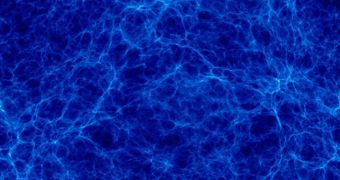Since the Big Bang exploded the Universe into being more than 13.75 billion years ago, large-scale cosmic structures have evolved following roughly the same patterns, regardless of whether they are made up of normal matter or dark matter.
This is the groundbreaking conclusion of a new computer model analyzing the situation. The simulation was conducted by an international team of Russian, German and Polish scientists, all of whom are experts in astrophysics or cosmology.
Over the past few years, these investigators have been piecing large volumes of data together, in order to create a high-resolution computer simulation of how the dark matter and baryonic matter clouds that fill the Universe evolved.
The work was carried out by experts at the University of Warsaw (FUW) Faculty of Physics, in Poland, the Lebedev Physical Institute of the Russian Academy of Sciences, and the Institute for Astrophysics, in Potsdam, Germany, AlphaGalileo reports.
What this study suggests is that earlier assumptions on the basic nature of dark matter – including how the stuff is distributed at the large scale – were correct. Dark matter was never detected by conventional means, but physicists determined its existence from the gravitational pull it exerts on baryonic matter.
“It turns out that normal matter, which makes up our everyday world, is but a slight addition to dark matter. There is at least six times more of the latter in the Universe – and nobody knows what it is,” explains FUW professor Marek Demiański.
“Discovering its nature is a thrilling experience,” the expert goes on to say. Calculations have shown that galaxy clusters contain 100 to 500 times more dark matter than normal matter, while typical galaxies contain between 10 and 50 times more of the elusive stuff.
The new results have considerably implications for the field of astrophysics. Experts say that the data could be used to gain a much deeper understanding of the way the Universe looked like when it was just a fraction of its current age and size.
“This similarity between the processes of evolution of both types of matter makes it possible to recreate the distribution of dark matter on the basis of the distribution of normal matter,” Demiański says.
“Our simulations have confirmed this effect and we can now say with greater certainty that we are able to gain insight into the invisible world of dark matter by observing the motion of galaxy clusters,” he concludes.

 14 DAY TRIAL //
14 DAY TRIAL //